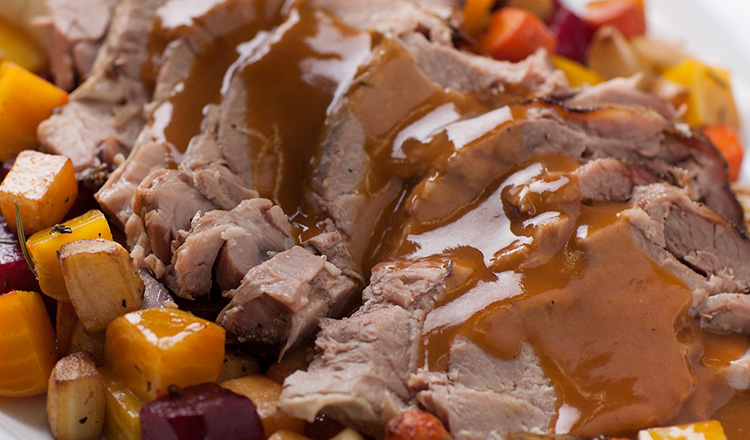Makes 6 servings
One 6- to 8-lb pork butt, bone in
Rub
Ingredients
- 2 tablespoons kosher salt
- 1 tablespoon sugar
- 2 teaspoons freshly cracked black pepper
- 1 teaspoon caraway seeds
- Grated zest of 1 lemon
Pan Gravy
Ingredients
- 1 cup chopped onion
- 1/2 cup chopped carrot
- 1/2 cup red wine
- 1/4 cup tomato paste
- 1/2 cup all-purpose flour
- 1 qt chicken or pork broth, chilled, plus more as needed
- Kosher salt, as needed
- Freshly ground black pepper, as needed
Directions
- If the skin is still on the pork, remove it along with most of the exterior fat, leaving no more than a 1/4-inch-thick layer.
- To make the rub: Combine the salt, sugar, pepper, caraway seeds, and lemon zest. Massage the rub into the pork and wrap the pork tightly in plastic wrap. Place the wrapped pork into a large brining bag or roasting pan and store in the refrigerator for 12 to 24 hours.
- Remove the pork from the refrigerator. Unwrap it, but do not rinse it. Place it fat side up in a roasting pan fitted with a rack. Preheat the oven to 250°F and let the pork rest at room temperature for 30 minutes while the oven is preheating.
- Insert a probe into the center of the pork, avoiding any bones or fat pockets. (A fat pocket can be easily seen; it is between the seams of muscles on the side of the butt that does not contain the bone.) Attach the other end of the probe into a thermometer so that you can monitor the internal temperature of the pork while it is cooking. (This option may also be available on your oven.)
- Place the pork on the center shelf of the oven. Roast with the fat side up for 2 hours. Turn the pork over and roast it with the fat side down for 2 more hours. Turn the pork over a final time and allow it to finish roasting with the fat side up. Each time you turn the pork, check to make sure that the juices have not dried up and are not burning on the bottom of the roasting pan. If the pan is dry, add a few tablespoons of water. The pan drippings are important to the sauce preparation and should not be allowed to burn.
- The pork’s temperature will stay around 160°F for an extended period of time, as long as 2 hours. You may start to doubt your thermometer, but it is not broken. Be patient. When the temperature breaks away from this plateau, and moves above 170°F, add the onion and carrot to the pan. At this point, begin to watch the meat more closely, because the temperature will now increase steadily. When the pork has reached an internal temperature of 185°F, remove it from the oven. Cooking to this temperature will leave enough texture in the meat for it to be easily sliced; if you would like to serve the meat pulled, in large chunks, or chopped, allow the pork to reach an internal temperature of 193°F before removing it from the oven. Allow the pork to rest, loosely covered with aluminum foil.
- While the pork is resting, prepare the pan gravy: Remove the pork and rack from the roasting pan. Drain off and discard all but 2 tablespoons of the fat, being careful not to pour out any of the pan drippings or vegetables.
- Place the roasting pan on the stovetop over medium heat and add ¼ cup of the red wine to help lift and dissolve the juices and particles that have accumulated in the bottom of the roasting pan during cooking. It’s important that these juices and particles on the bottom of the pan are not burnt, since they provide the majority of the sauce’s flavor. Simmer until all the wine has evaporated and only the fat is remaining. Add the tomato paste and cook, stirring constantly, until the tomato paste has lost its red color and caramelized to a deep brown. Add the remaining 1/4 cup red wine and cook until all the wine has evaporated. When the wine has evaporated, add the flour and continue to cook, stirring constantly, for 2 minutes. Whisk in the broth until everything is dissolved in the broth. Increase the heat to bring the mixture to a boil, then reduce the heat to establish a gentle simmer. Simmer until the gravy reaches the desired consistency, at least 25 minutes. While the gravy is simmering, taste it periodically and season it with salt and pepper if necessary. If the gravy is too thin, continue reducing it until it thickens to the proper consistency; if it is too thick, thin it as needed with more broth. Adjust the seasoning with additional salt and pepper, if necessary, and then strain the gravy into a bowl or serving dish to remove any lumps.
- Remove the bones from the pork, slice, pull, or chop the meat, and serve with the pan gravy.


